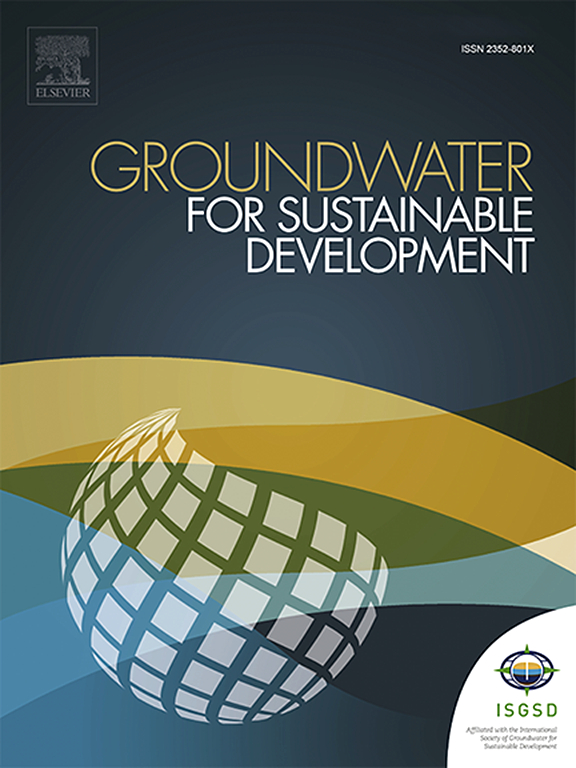Groundwater dynamics and hydrogeological processes in the Alter do Chão Aquifer: A case study in Manaus, Amazonas – Brazil
IF 4.9
Q2 ENGINEERING, ENVIRONMENTAL
引用次数: 0
Abstract
Fluctuations in groundwater levels can occur for several reasons related to hydrological, geological, climatic, or even anthropogenic influences due to aquifer exploitation and land use change. In Manaus, the capital of the State of Amazonas, in Brazil, the Alter do Chão Aquifer (ACA) is the main source for private water supply. The recent extreme droughts that affected the Amazon region confirmed the relevance and importance of the ACA water reserves, which must be better understood and studied to promote effective, balanced, and informed groundwater resources management. Even with a monitoring network spread over the city collecting continuous data, information about groundwater levels is not effectively used for water management purposes. Understanding the levels variations, the dynamics of groundwater and the factors that influence groundwater behaviour becomes fundamental in times of water crisis, scarcity, and intensification of extreme climatic events. The objective of this work was to understand the behaviour of groundwater levels in the ACA to determine the main factors influencing groundwater reserve fluctuations under different stresses. Four wells monitored between 2010 and 2023 were analysed using physical-based time series models. The models incorporated time series of precipitation, evapotranspiration, river stage and linear trends from climatological events that occurred in certain periods as multiple inputs and possible stresses in the ACA reserves. The results demonstrate that the ACA presents fast responses to climatological inputs. Even located in the same hydrogeological context, the wells reveal different responses to precipitation and evapotranspiration, the major factors of influence. Also, significant trends were found during El Niño (2014–2016) and La Niña (2020–2023) events. This information can be used for planning water use, understanding the mechanisms of recharge and discharge of groundwater, for drilling new wells and exploring new areas with potential for economic and social growth, in line with environmental preservation.

Alter do ch含水层的地下水动力学和水文地质过程:以巴西亚马逊州马瑙斯为例
地下水水位的波动可由若干原因引起,这些原因与水文、地质、气候,甚至是由于含水层开采和土地利用变化造成的人为影响有关。在巴西亚马逊州首府马瑙斯,Alter do ch含水层(ACA)是私人供水的主要来源。最近影响亚马逊地区的极端干旱证实了ACA水资源储备的相关性和重要性,必须更好地了解和研究它,以促进有效、平衡和知情的地下水资源管理。即使有一个监测网络遍布整个城市,收集连续的数据,有关地下水位的信息并没有有效地用于水管理目的。在水危机、缺水和极端气候事件加剧的时期,了解水位变化、地下水动态和影响地下水行为的因素变得至关重要。这项工作的目的是了解地下水位的行为,在不同的应力下确定影响地下水储量波动的主要因素。使用基于物理的时间序列模型对2010年至2023年间监测的4口井进行了分析。该模型将降水、蒸散、河段和特定时期气候事件的线性趋势的时间序列作为多个输入和ACA储备的可能压力。结果表明,ACA对气候输入有快速响应。即使位于相同的水文地质环境,这些井对降水和蒸散发的响应也不同,这是主要的影响因素。此外,在El Niño(2014-2016)和La Niña(2020-2023)事件期间也发现了显著的趋势。这些资料可用于规划用水、了解地下水补给和排放的机制、在符合环境保护的情况下钻新井和勘探具有经济和社会增长潜力的新地区。
本文章由计算机程序翻译,如有差异,请以英文原文为准。
求助全文
约1分钟内获得全文
求助全文
来源期刊

Groundwater for Sustainable Development
Social Sciences-Geography, Planning and Development
CiteScore
11.50
自引率
10.20%
发文量
152
期刊介绍:
Groundwater for Sustainable Development is directed to different stakeholders and professionals, including government and non-governmental organizations, international funding agencies, universities, public water institutions, public health and other public/private sector professionals, and other relevant institutions. It is aimed at professionals, academics and students in the fields of disciplines such as: groundwater and its connection to surface hydrology and environment, soil sciences, engineering, ecology, microbiology, atmospheric sciences, analytical chemistry, hydro-engineering, water technology, environmental ethics, economics, public health, policy, as well as social sciences, legal disciplines, or any other area connected with water issues. The objectives of this journal are to facilitate: • The improvement of effective and sustainable management of water resources across the globe. • The improvement of human access to groundwater resources in adequate quantity and good quality. • The meeting of the increasing demand for drinking and irrigation water needed for food security to contribute to a social and economically sound human development. • The creation of a global inter- and multidisciplinary platform and forum to improve our understanding of groundwater resources and to advocate their effective and sustainable management and protection against contamination. • Interdisciplinary information exchange and to stimulate scientific research in the fields of groundwater related sciences and social and health sciences required to achieve the United Nations Millennium Development Goals for sustainable development.
 求助内容:
求助内容: 应助结果提醒方式:
应助结果提醒方式:


